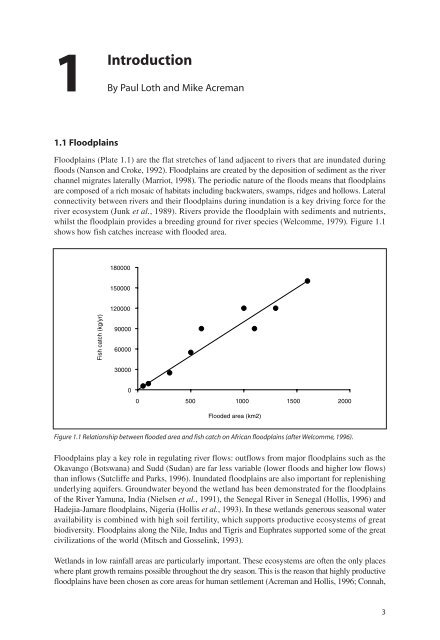The return of the water - IUCN
The return of the water - IUCN
The return of the water - IUCN
You also want an ePaper? Increase the reach of your titles
YUMPU automatically turns print PDFs into web optimized ePapers that Google loves.
1<br />
1.1 Floodplains<br />
Introduction<br />
By Paul Loth and Mike Acreman<br />
Floodplains (Plate 1.1) are <strong>the</strong> flat stretches <strong>of</strong> land adjacent to rivers that are inundated during<br />
floods (Nanson and Croke, 1992). Floodplains are created by <strong>the</strong> deposition <strong>of</strong> sediment as <strong>the</strong> river<br />
channel migrates laterally (Marriot, 1998). <strong>The</strong> periodic nature <strong>of</strong> <strong>the</strong> floods means that floodplains<br />
are composed <strong>of</strong> a rich mosaic <strong>of</strong> habitats including back<strong>water</strong>s, swamps, ridges and hollows. Lateral<br />
connectivity between rivers and <strong>the</strong>ir floodplains during inundation is a key driving force for <strong>the</strong><br />
river ecosystem (Junk et al., 1989). Rivers provide <strong>the</strong> floodplain with sediments and nutrients,<br />
whilst <strong>the</strong> floodplain provides a breeding ground for river species (Welcomme, 1979). Figure 1.1<br />
shows how fish catches increase with flooded area.<br />
Fish catch (kg/yr)<br />
180000<br />
150000<br />
120000<br />
90000<br />
60000<br />
30000<br />
0<br />
0 500 1000 1500 2000<br />
Flooded area (km2)<br />
Figure 1.1 Relationship between flooded area and fish catch on African floodplains (after Welcomme, 1996).<br />
Floodplains play a key role in regulating river flows: outflows from major floodplains such as <strong>the</strong><br />
Okavango (Botswana) and Sudd (Sudan) are far less variable (lower floods and higher low flows)<br />
than inflows (Sutcliffe and Parks, 1996). Inundated floodplains are also important for replenishing<br />
underlying aquifers. Ground<strong>water</strong> beyond <strong>the</strong> wetland has been demonstrated for <strong>the</strong> floodplains<br />
<strong>of</strong> <strong>the</strong> River Yamuna, India (Nielsen et al., 1991), <strong>the</strong> Senegal River in Senegal (Hollis, 1996) and<br />
Hadejia-Jamare floodplains, Nigeria (Hollis et al., 1993). In <strong>the</strong>se wetlands generous seasonal <strong>water</strong><br />
availability is combined with high soil fertility, which supports productive ecosystems <strong>of</strong> great<br />
biodiversity. Floodplains along <strong>the</strong> Nile, Indus and Tigris and Euphrates supported some <strong>of</strong> <strong>the</strong> great<br />
civilizations <strong>of</strong> <strong>the</strong> world (Mitsch and Gosselink, 1993).<br />
Wetlands in low rainfall areas are particularly important. <strong>The</strong>se ecosystems are <strong>of</strong>ten <strong>the</strong> only places<br />
where plant growth remains possible throughout <strong>the</strong> dry season. This is <strong>the</strong> reason that highly productive<br />
floodplains have been chosen as core areas for human settlement (Acreman and Hollis, 1996; Connah,<br />
3












